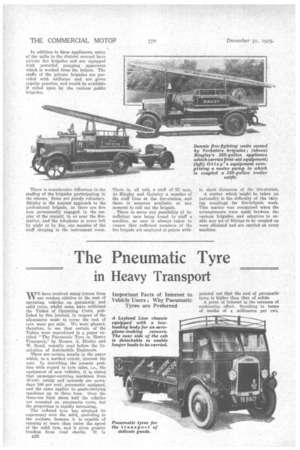The Pneumatic Tyre
Page 60

Page 61

If you've noticed an error in this article please click here to report it so we can fix it.
in Heavy Transport
Important Facts of Interest to Vehicle Users ; Why Pneumatic Tyres are Preferred WE have received many letters from our readers relative to the cost of operating vehicles on .pneUmatic and solid tyres, whilst Some have criticized the Tables of Operating Costs, published by this journal, in respect of the allowances made to cover the cost of tyre wear per mile. We were pleased, therefore, to see that certain of the 'fables were reproduced in a paper entitled "The Pneumatic Tyre in Heavy Transport," by Messrs. A. Healey and W. Bond, recently read before the Institution of Automobile Engineers.
There are certain details -in the paper which, to a marked extent, interest the user. In describing the present position with regard to tyre sales, i.e., the equipment of new vehicles, it is stated that passenger-carrying machines from :30-ewt. rating and upwards are nowadays 100 per cent. pneumatic equipped, and the same applies to goods-carrying machines up to three tons. Over the three-ton limit about half the vehicles are mounted an pneumatic tyres, but the proportion is rapidly increasing, The inflated tyre has attained its supremacy over the solid, accOrding to the authors, because it is capable Of running at more than twice the, speed of the solid tyre, and it gives greater &eel:14)m from road shocks. 'It is B26 pointed out that the cost of pneumatic tyres is higher than that of solids.
A point of interest is the measure of cushioning effect. Speaking in terms of tenths of a millimetre per ewt. increase in load (if the normal loan ne already applied to the tyre), the solid has a figure of merit of 2, the cushion 4, the pneumatic 8 and the low-pressure bus tyre of 10.
A common misconception is dispelled by the statement that the pneumatic tyre absorbs more power than does the solid. For example, at 33 m.p.h. the pneumatic absorbs 1.3 b.p., whereas the solid absorbs 1.12 h.p.
Despite this fact less petrol is consumed by a vehicle which is shod with inflated tyres, because a more economical engine speed can be maintained, whilst there is less waste Of power in spring deflection and general 'vibration.
The effect of load and inflation pressure upon the temperature assumed by a pneumatic tyre is interesting. For example, at 50 m.p.h. a vehicle laden with di cwt. has a tyre temperature of 70 degrees C., whereas, when the load is increased to 15 cwt. the temperature rises to well over 100 degrees. The effect of pressure upon temperature is shown in a graph depicting the rise in temperature in a tyre run at 21 m.p.h., the normal pressure of which would be 95 lb. per sq. in.; at that pressure the running temperature is 75 degrees C., whereas when the pressure falls to 50 lb. per sq. in. the temperature is approximately 79 degrees, whilst at about 33 lb. per sq. in. the thermometer registers 105 degrees.
The Effect of Speed.
Yet another graph reveals the effect of speed on temperature attained by a giant pneumatic tyre. At a constant load of 18 cwt., and a pressure of 60 lb. per sq. in. the temperature is 40 degrees C. when running at 8 m.p.h.; at 20 m.p.h. the temperature is 74 degrees, whilst at 38 m.p.h. the temperature is over 110 degrees.
The use of pneumatic tyres has a great influence upon the economic radius of operation of a vehicle. For example, in. order to carry 100 tons of material 100 miles in one day more vehicles will be required if solid tyres be employed. A 5-ton pneumatic-shod vehicle could run 200 miles in a day with no more effort than a similar vehicle shod with solid tyres which ran only 120 miles. It will, therefore, be realized that 10 pneumatic-tyred machines could do the work of 16.7 solid-tyred vehicles. This is not the only point, as there is less charge for interest on capital for the 10 lorries as compared with that on 16.7, and each driver's wage of, say, £3, is distributed over 1,000 miles as compared with only 600 miles. In a section of the paper dealing with legislation in regard to transport, it is stated that metal tyres are prohibited on commercial vehicles in five countries, rubber tyres are compulsory in two, pneumatics are enforced by law in four lands, whilst in 35 countries there is an extra tax on solid tyres. No fewer than 26 Governments issue miscellaneous regulations defining the size of tyres, weights of vehicles, etc.




































































































